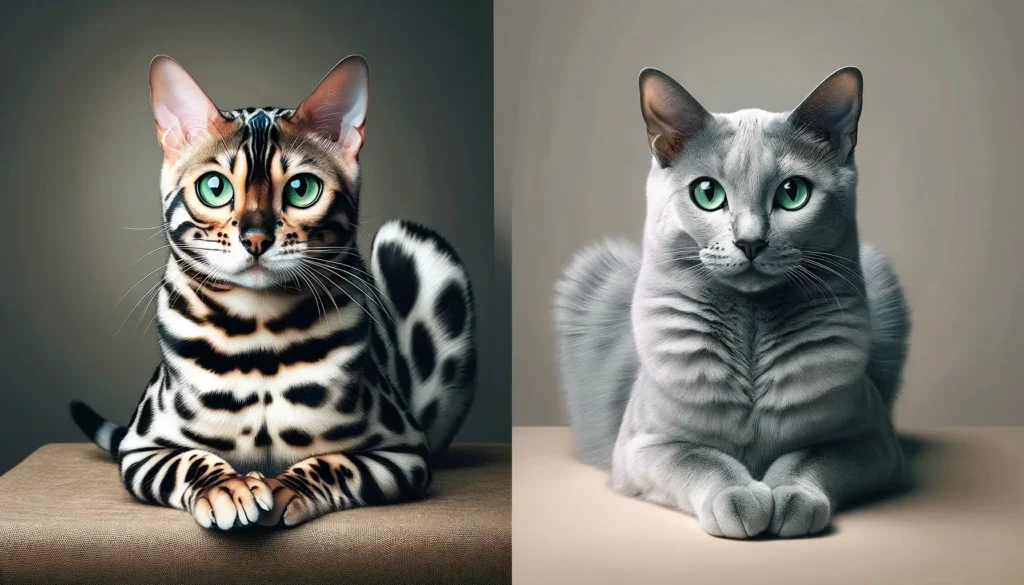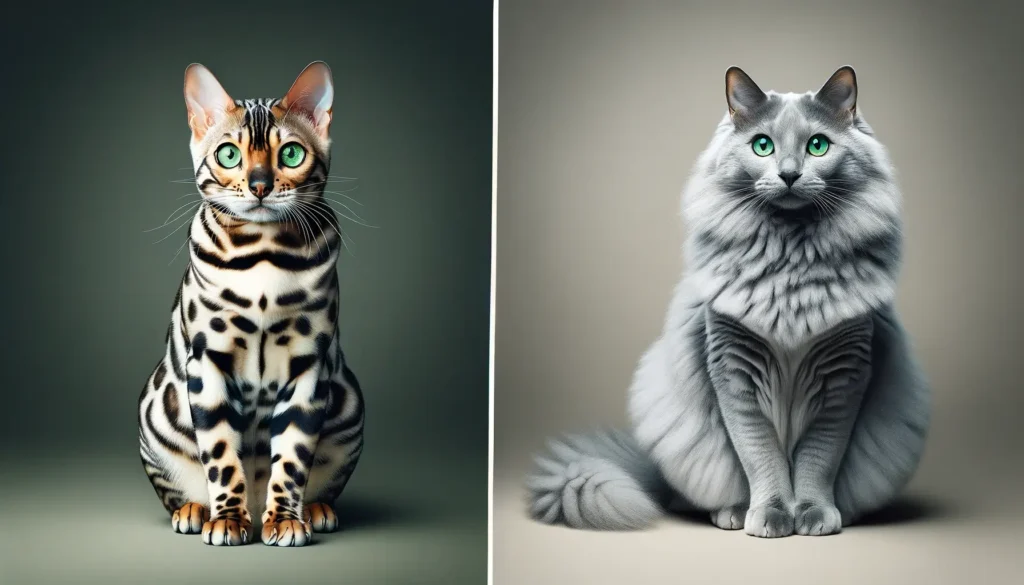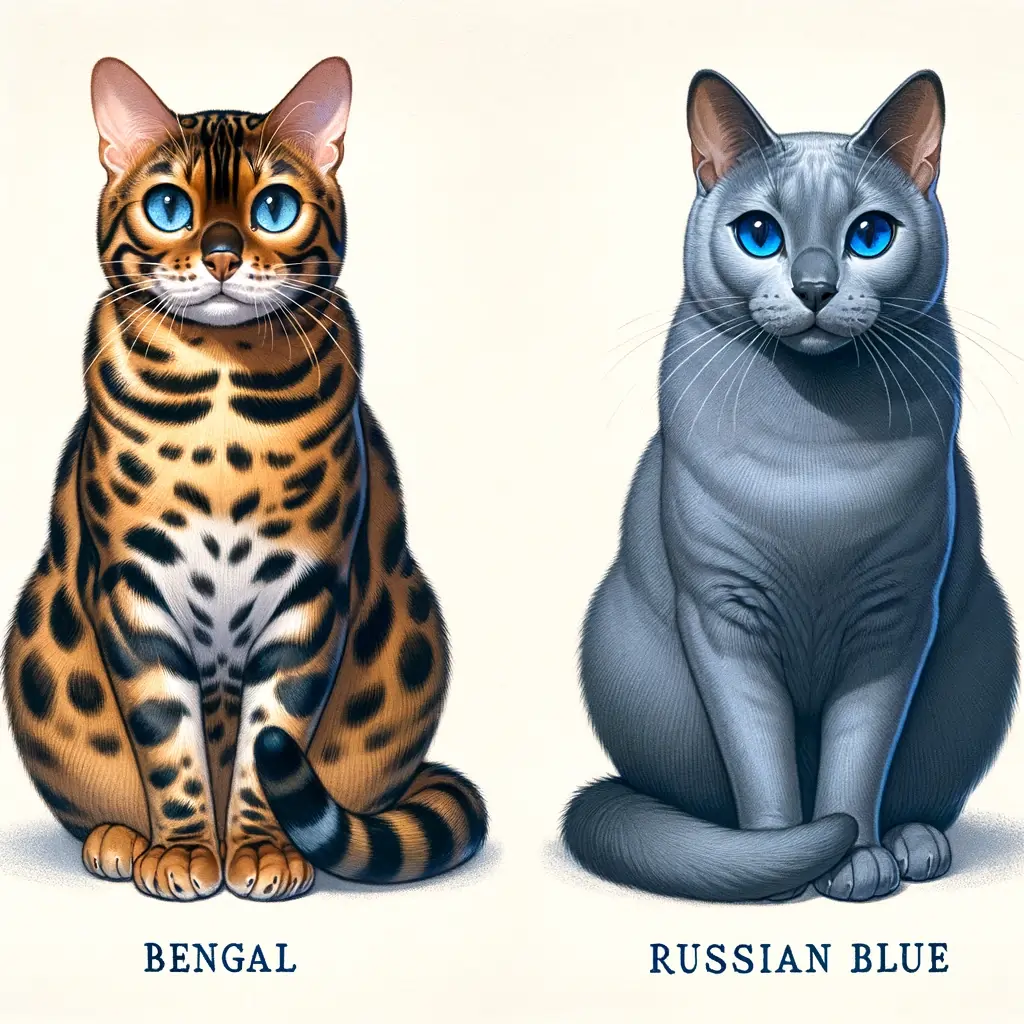Welcome to our comprehensive breed comparison between the Bengal vs Russian Blue cat breeds. If you’re considering adding a feline companion to your household, it can be challenging to decide which breed is the best fit for you. In this article, we will provide you with all the information you need to make an informed decision.
Visual differences
| Feature | Bengal | Russian Blue |
|---|---|---|
| Origin | United States | Russia |
| Size | Medium to large | Medium |
| Weight | Males: 10-15 lbs, Females: 8-12 lbs | Males: 10-12 lbs, Females: 7-10 lbs |
| Coat Type | Short, thick, and luxurious | Short, dense, and fine |
| Coat Color | Spotted or marbled in various shades, often golden or sandy backgrounds | Uniformly blue-gray with a silvery sheen |
| Eye Color | Usually green or gold | Vivid green |
| Lifespan | 12-16 years | 15-20 years |
| Personality | Active, playful, enjoys water | Gentle, quiet, loyal |
| Health Issues | Prone to heart diseases like HCM, PRA (Progressive Retinal Atrophy) | Generally healthy but can have genetic predispositions to certain conditions like bladder stones |
| Maintenance | Low; occasional brushing | Low; weekly brushing |
| Suitability | Active families, those looking for an engaging pet | Families or individuals seeking a quiet, loyal companion |
Bengal vs Russian Blue Cat Size, Coat, and Temperament
When comparing the Bengal and Russian Blue cat breeds, it’s important to consider their size, coat, and temperament. These characteristics play a significant role in determining which breed will be the best fit for your lifestyle and preferences.
Size
The Bengal cat is known for its muscular and athletic build. As a medium to large-sized breed, adult male Bengals typically weigh between 10 to 15 pounds (4.5 to 6.8 kilograms), while females weigh between 7 to 10 pounds (3.2 to 4.5 kilograms). They have a solid and sturdy frame that showcases their natural agility and strength.
On the other hand, the Russian Blue cat is smaller in size compared to the Bengal. Adult males generally weigh between 10 to 12 pounds (4.5 to 5.4 kilograms), while females typically weigh around 7 to 10 pounds (3.2 to 4.5 kilograms). Despite their smaller size, Russian Blues have a delicate and elegant appearance.
Coat
One of the most striking features of Bengal cats is their beautifully patterned coat. They have a short, thick, and luxurious coat that comes in various colors and patterns, including spots, rosettes, and marbled designs. The Bengal’s coat is known for its soft and silky texture, which requires minimal grooming.
In contrast, Russian Blue cats are renowned for their dense and plush coats. Their fur is short, but it possesses a double-layered structure that provides them with excellent insulation. The coat is solid blue and produces a shimmering effect, giving the Russian Blue a captivating appearance. Grooming the Russian Blue’s coat is relatively low maintenance, as it only requires regular brushing to keep it looking its best.
Temperament
Bengal cats are often described as active, curious, and highly intelligent. They thrive in environments that offer them mental and physical stimulation, such as interactive toys and playtime with their owners. Bengals are known for their playful and energetic nature while also being affectionate and social with their human companions.
Russian Blue cats, on the other hand, have a more reserved and calm temperament. They are typically gentle, loyal, and affectionate towards their owners. Russian Blues are known for their quiet demeanor and their tendency to form strong bonds with their primary caregiver. They are less demanding in terms of playtime and are content with observing their surroundings and enjoying the company of their loved ones.
Understanding the size, coat, and temperament differences between Bengal and Russian Blue cats can help you make an informed decision when choosing a feline companion. Whether you prefer an active and outgoing cat like the Bengal or a calm and affectionate cat like the Russian Blue, both breeds have unique qualities that make them wonderful companions.

Bengal cat vs Russian Blue cat
Bengal vs Russian Blue Cat Personality and Activity Levels
When considering bringing a Bengal or Russian Blue cat into your home, understanding their personality traits and activity levels is essential. These characteristics can significantly impact how well they fit into your household dynamics and lifestyle.
The Bengal cat is known for its high-energy and playful nature. They are often described as active, curious, and adventurous. Bengals are intelligent and require mental stimulation, so providing them with interactive toys and engaging activities is essential to keep them happy and content. Being highly social, Bengals thrive in households where they receive ample attention and interaction.
They enjoy being part of the family and participating in daily activities. However, their playful and energetic nature can sometimes lead to mischief if not provided with proper outlets for their energy.
On the other hand, Russian Blue cats are known for their laid-back and calm demeanor. They are typically reserved and prefer a quieter environment. Russian Blues are less active and tend to be content with gentle play sessions and calm companionship. These cats are intelligent and enjoy activities that stimulate their minds, such as puzzle toys or interactive games.
While Russian Blues can be affectionate and enjoy spending time with their owners, they are also independent and can entertain themselves if necessary.
Introducing a New Cat to Your Household: Bengal vs Russian Blue
If you already have a cat or are considering adding a new feline companion to your household, it’s important to understand how Bengals and Russian Blues behave around other cats. Successful introductions are crucial for ensuring a harmonious and stress-free environment for all your furry friends.
Both Bengal and Russian Blue cats have unique personalities and temperaments that can influence how well they adapt to living with other cats. Here are some insights and tips to help you navigate the process:
- Slow and gradual introductions: Start by allowing the cats to familiarize themselves with each other’s scents. Exchange bedding or use pheromone sprays to help create a sense of familiarity. Gradually move on to supervised face-to-face interactions in a controlled and neutral territory, such as a separate room or a large crate. Monitor their behavior closely and be prepared to separate them if necessary.
- Supervised interaction: During the initial stages, ensure that the cats are supervised whenever they are together. This allows you to intervene if any aggression or tension arises. Keep interactions short and gradually increase the duration as they become more comfortable with each other.
- Positive associations: Encourage positive associations between the cats by offering treats or playtime when they are in each other’s presence. This helps create a positive and rewarding experience, associating each other’s company with something enjoyable.
- Slow integration: Avoid rushing the process of integrating the cats into one another’s space. Start by giving them separate feeding stations, litter boxes, and resting areas. Gradually merge these resources as they begin to feel more comfortable with each other’s presence.
- Seek professional assistance: If you’re unsure about how to introduce your cats or if the process becomes challenging, don’t hesitate to seek guidance from a professional animal behaviorist or a veterinarian experienced in cat behavior. They can provide tailored advice and strategies to make the introduction smoother.

Conclusion
In conclusion, the comparison between Bengal and Russian Blue cats reveals that both breeds have their own unique charm and characteristics. When choosing between these two breeds, it is important to consider factors such as size, coat, temperament, personality, activity levels, and compatibility with other cats.
Size-wise, Bengals tend to be larger and more muscular, while Russian Blues are known for their slim and elegant physique. In terms of coat, Bengals have a distinctive marbled or spotted pattern, while Russian Blues boast a short, dense, and plush blue coat.
When it comes to temperament, Bengals are typically highly energetic, playful, and curious, making them a good fit for active households. On the other hand, Russian Blues are known for their calm and gentle nature, making them great companions for a quieter and more relaxed environment.
Ultimately, the best companion for you will depend on your personal preferences and lifestyle. Whether you choose a Bengal or a Russian Blue, each breed offers its own set of unique qualities that can bring joy and companionship to your life. Remember to spend time getting to know your potential feline friend before making a decision, as every cat is an individual with their own personality and needs.
FAQs
Q: What are the main differences between Bengal and Russian Blue cats?
A: Bengal cats tend to be more active and playful, while Russian Blue cats are known for their calm and gentle demeanor.
Q: Are Bengal kittens more energetic than Russian Blue kittens?
A: Yes, Bengal kittens are typically more playful and lively compared to the more mellow Russian Blue kittens.
Q: Is grooming a Bengal cat more challenging than grooming a Russian Blue cat?
A: Both breeds have easy-to-maintain coats, but Bengal cats may require a bit more grooming due to their unique coat patterns.
Q: Do Bengal and Russian Blue cats get along well with other pets?
A: Both breeds can get along with other pets if introduced properly, but Russian Blue cats tend to be more accepting of new animals in the household.

Hey guys, My name is Simon Smith. I’m from Canada and live near Victoria
I live with my sweet family and have 20+ Ragdolls of different types. I love them as my own children. My profession is as a hotel manager.
I love to keep Ragdolls and grow their breeder case. I have 7 years of experience.
I’m an expert in cat care. So, I’m here to provide you with new information about my cats daily. This is my personal blog website, so I request that you kindly visit our site daily.
If you’re a Ragdolls lover and you have any questions or confusion about cats, text me on the Contact Us page or Gmail.
Thank u
